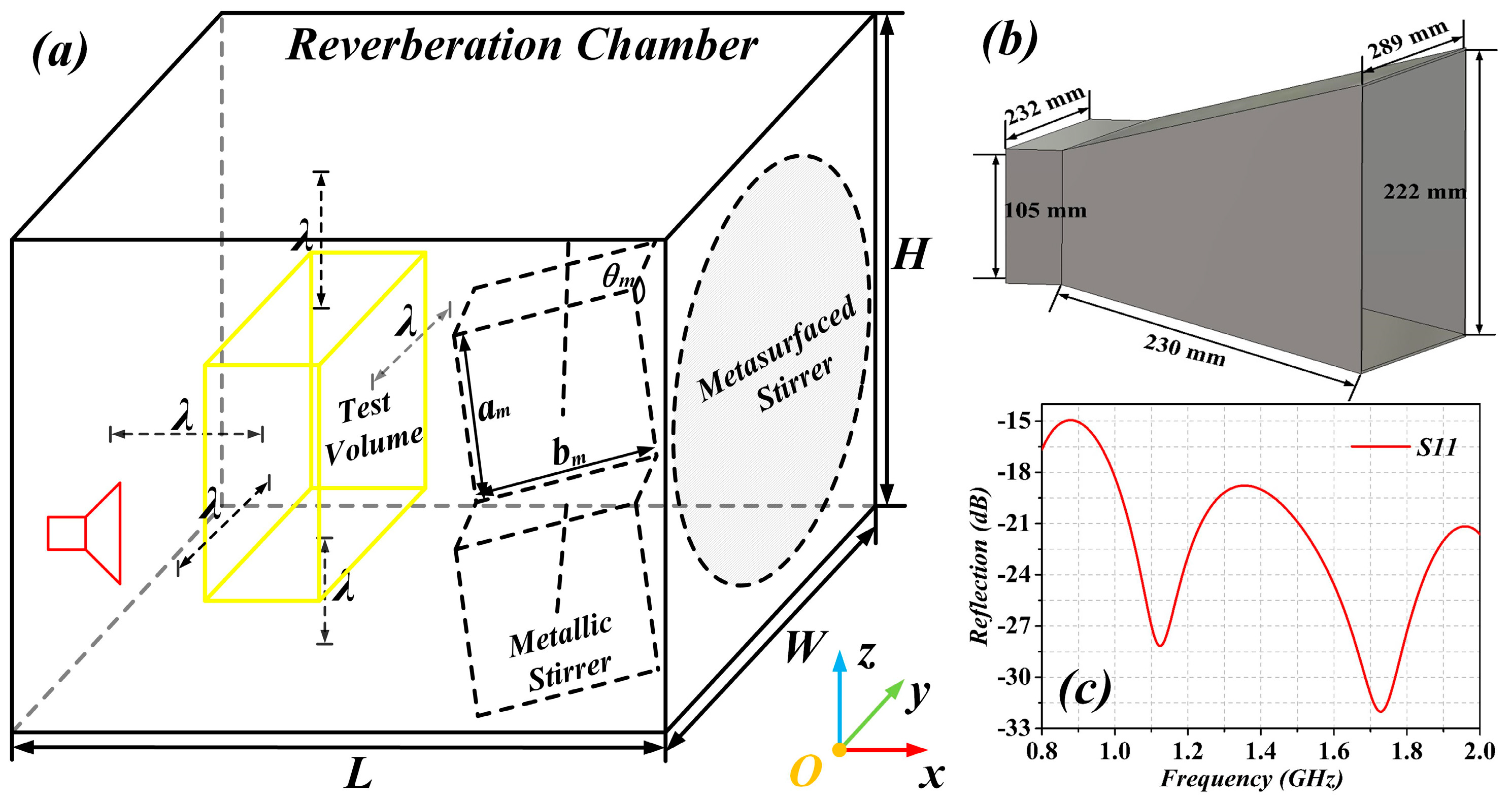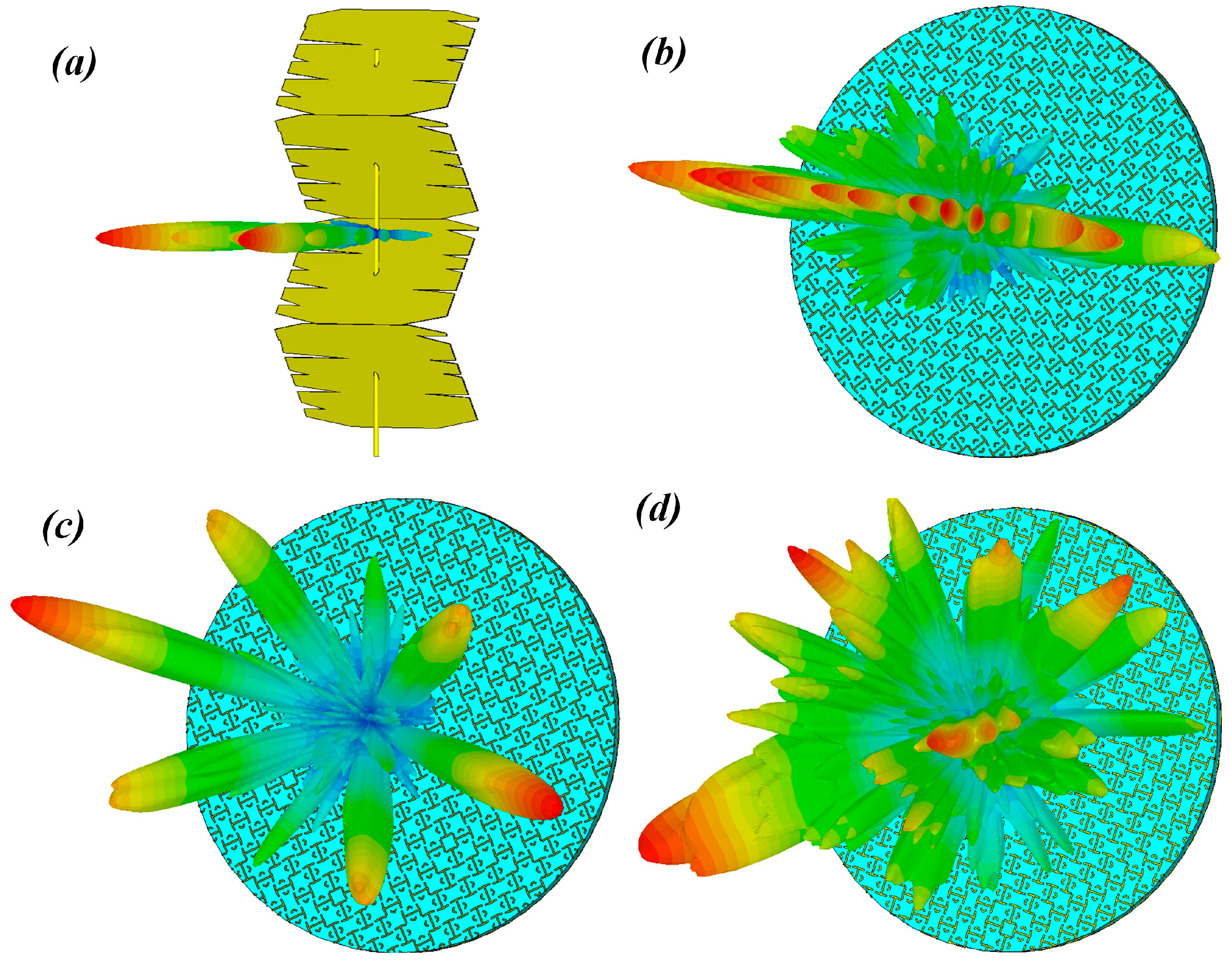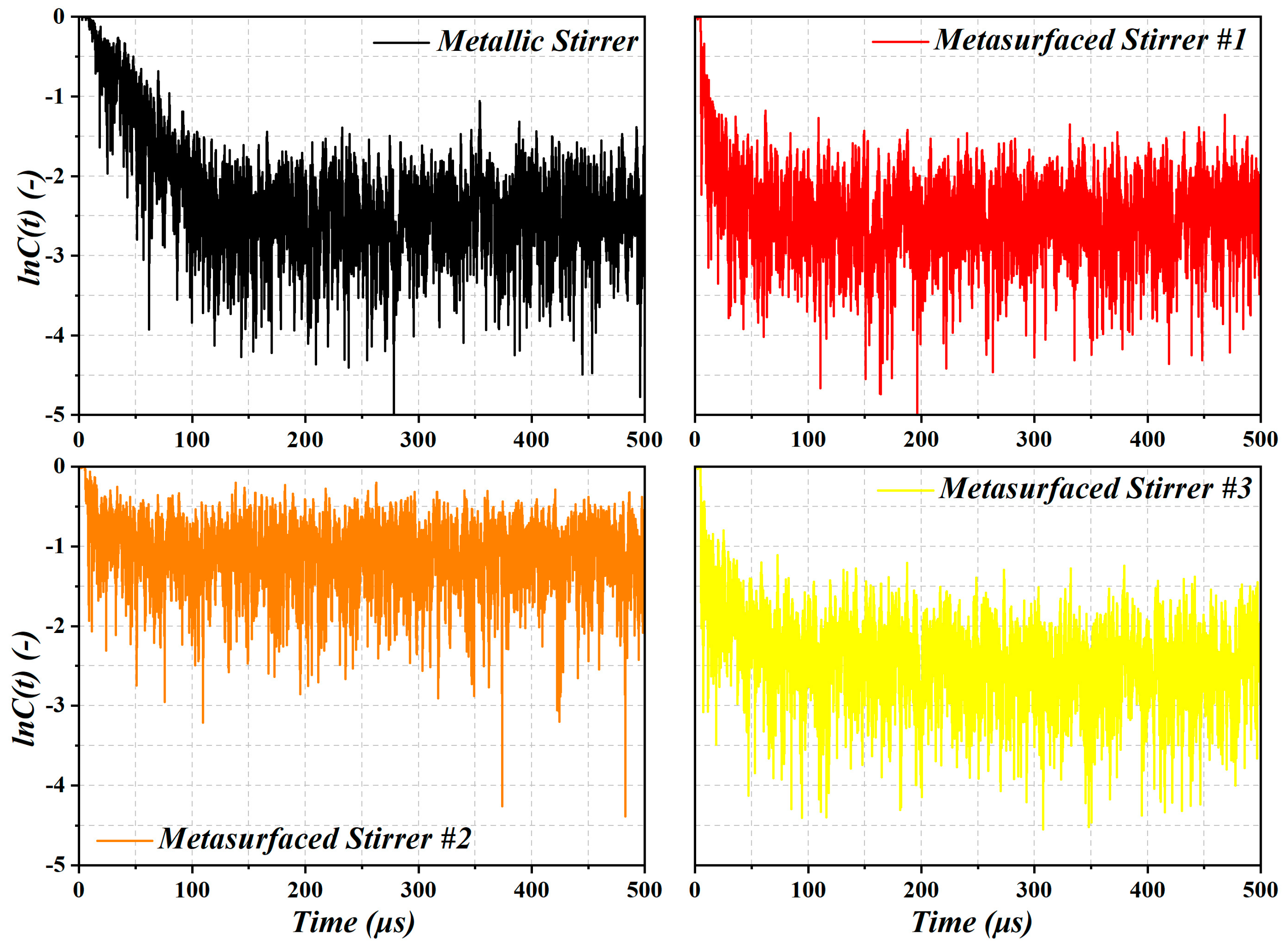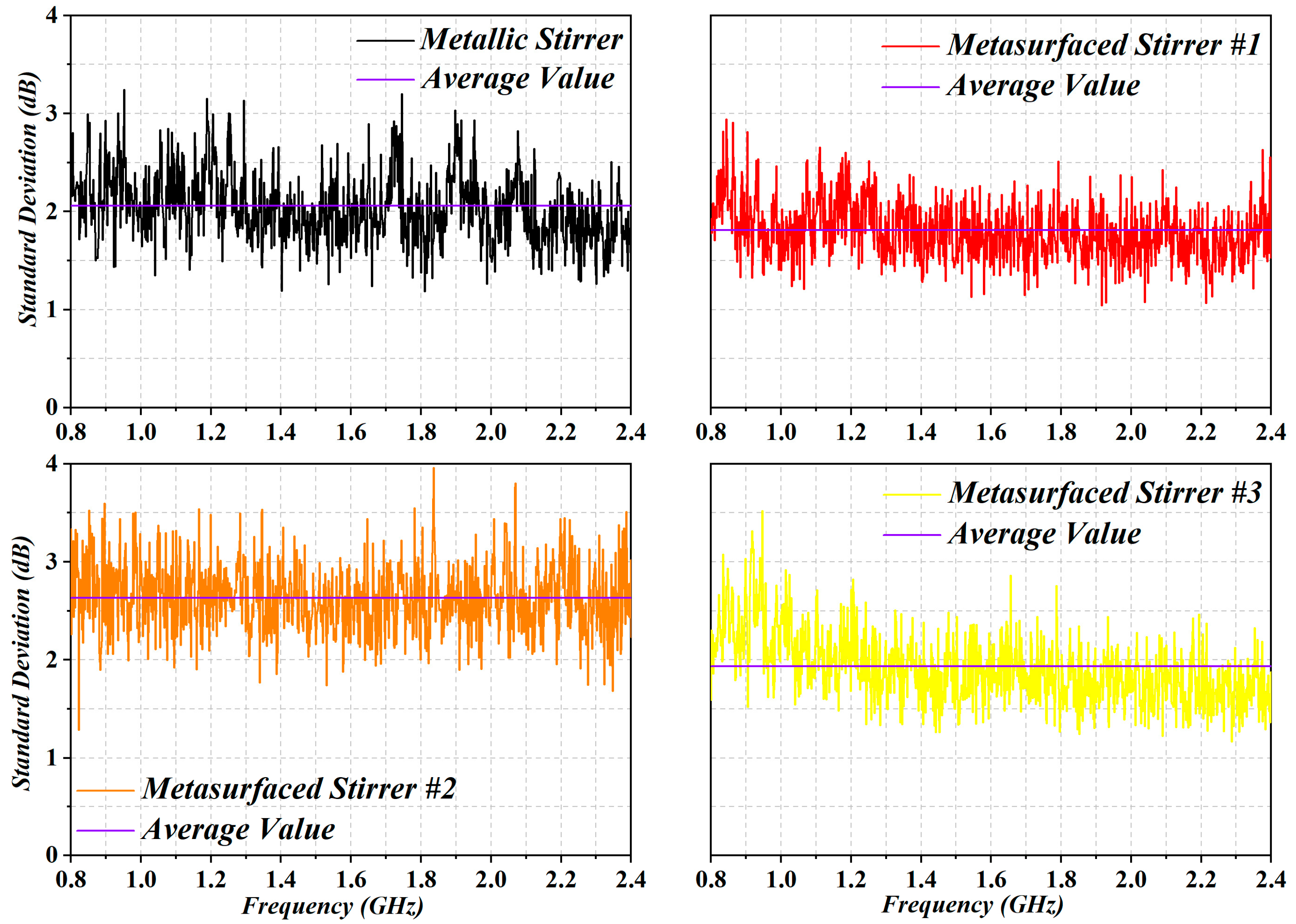Parametric Testing of Metasurface Stirrers for Metasurfaced Reverberation Chambers
Abstract
1. Introduction
1.1. Simulation Parameters Set Up
1.2. Analysis of Simulation Results
2. Conclusions
Author Contributions
Funding
Acknowledgments
Conflicts of Interest
References
- Wu, D.I.; Chang, D.C. The effect of an electrically large stirrer in a mode-stirred chamber. IEEE Trans. Electromagn. Compat. 1989, 31, 164–169. [Google Scholar] [CrossRef]
- Serra, R.; Leferink, F. Optimizing the stirring strategy for the vibrating intrinisic reverberation chamber. In Proceedings of the 9th International Symposium on EMC and 20th International Wroclaw Symposium on Electromagnetic Compatibility, Wroclaw, Poland, 13–17 September 2010. [Google Scholar]
- Clegg, J.; Marvin, A.C.; Dawson, J.F.; Porter, S.J. Optimization of stirrer designs in a reverberation chamber. IEEE Trans. Electromagn. Compat. 2005, 47, 824–832. [Google Scholar] [CrossRef]
- Bruns, C. Three-Dimensional Simulation and Experimental Verification of a Reverberation Chamber. Ph.D. Thesis, Swiss Federal Institute of Technology in Zurich (ETH Zurich), Zurich, Switzerland, 2005. [Google Scholar]
- Moglie, F.; Primiani, V.M. Analysis of the independent positions of reverberation chamber stirrers as a function of their operating conditions. IEEE Trans. Electromagn. Compat. 2011, 53, 288–295. [Google Scholar] [CrossRef]
- Clegg, J. Optimization of stirrer designs in a reverberation chamber. IEEE Trans. Electromagn. Compat. 2002, 44, 442–457. [Google Scholar] [CrossRef]
- Plaza-González, P.; Monzó-Cabrera, J.; Catalá-Civera, J.M.; Sánchez-Hernández, D. Effect of mode-stirrer configurations on dielectric heating performance in multimode microwave applicators. IEEE Trans. Microw. Theory Tech. 2005, 53, 1699–1706. [Google Scholar] [CrossRef]
- Lundén, O.; Wellander, N.; Bäckström, M. Stirrer blade separation experiment in reverberation chambers. In Proceedings of the 2010 IEEE International Symposium on Electromagnetic Compatibility, Fort Lauderdale, FL, USA, 25–30 July 2010. [Google Scholar]
- Pfennig, S.; Krauthauser, H.G. Comparison of methods for determining the number of independent stirrer positions in reverberation chambers. In Proceedings of the 2013 International Symposium on Electromagnetic Compatibility, Brugge, Belgium, 2–6 September 2013. [Google Scholar]
- Pfennig, S.; Krauthäuser, H.G.; Moglie, F.; Primiani, V.M. A continued evaluation of the general method for determining the number of independent stirrer positions in reverberation chambers. In Proceedings of the 2014 International Symposium on Electromagnetic Compatibility, Gothenburg, Sweden, 1–4 September 2014. [Google Scholar]
- Sun, H.; Li, Z.; Gu, C.; Xu, Q.; Chen, X.; Sun, Y.; Lu, S.; Martin, F. Metasurfaced reverberation chamber. Sci. Rep. 2018, 8, 1577. [Google Scholar] [CrossRef] [PubMed]
- Cui, T.J.; Qi, M.Q.; Wan, X.; Zhao, J.; Cheng, Q. Coding metamaterials, digital metamaterials and programmable metamaterials. Light: Sci. Appl. 2014, 10, e218. [Google Scholar] [CrossRef]
- Sun, H.; Gu, C.; Li, Z.; Xu, Q.; Song, J.; Xu, B.; Dong, X.; Wang, K.; Martín, F. Enhancing the number of modes in metasurfaced reverberation chambers for field uniformity improvement. Sensors 2018, 18, 3301. [Google Scholar] [CrossRef] [PubMed]
- Sun, H.; Gu, C.; Chen, X.; Li, Z.; Liu, L.; Xu, B.; Zhou, Z. Broadband and broad-angle polarization-independent metasurface for radar cross section reduction. Sci. Rep. 2017, 7, 40782. [Google Scholar] [CrossRef] [PubMed]
- Lunden, O.; Backstrom, M. Stirrer efficiency in FOA reverberation chambers. Evaluation of correlation coefficients and chi-squared tests. In Proceedings of the IEEE International Symposium on Electromagnetic Compatibility. Symposium Record (Cat. No.00CH37016), Washington, DC, USA, 21–25 August 2000. [Google Scholar]
- Hill, D.A. Plane wave integral representation for fields in reverberation chambers. IEEE Trans. Electromagn. Compat. 1998, 40, 209–217. [Google Scholar] [CrossRef]
- Hill, D.A. Electromagnetic Fields in Cavities: Deterministic and Statistical Theories, 1st ed.; John Wiley & Sons, Inc.: Hoboken, NJ, USA, 2009; ISBN 978-0-470-46590-5. [Google Scholar]
- El Baba, I.; Lalléchère, S.; Bonnet, P.; Benoit, J.; Paladian, F. Computing total scattering cross section from 3-D reverberation chambers time modeling. In Proceedings of the 2012 Asia-Pacific Symposium on Electromagnetic Compatibility, Singapore, 21–24 May 2012. [Google Scholar]
- Xu, Q.; Huang, Y.; Xing, L.; Tian, Z.; Stanley, M.; Yuan, S. B-scan in a reverberation chamber. IEEE Trans. Antennas Propag. 2016, 64, 1740–1750. [Google Scholar] [CrossRef]
- Xu, Q.; Huang, Y.; Xing, L.; Tian, Z.; Song, C.; Stanley, M. The limit of the total scattering cross section of electrically large stirrers in a reverberation chamber. IEEE Trans. Electromagn. Compat. 2016, 58, 623–626. [Google Scholar] [CrossRef]
- Lerosey, G.; de Rosny, J. Scattering cross section measurement in reverberation chamber. IEEE Trans. Electromagn. Compat. 2007, 49, 280–284. [Google Scholar] [CrossRef]
- Hill, D.A.; Ma, M.T.; Ondrejka, A.R.; Riddle, B.F.; Crawford, M.L.; Johnk, R.T. Aperture excitation of electrically large, lossy cavities. IEEE Trans. Electromagn. Compat. 1994, 36, 169–178. [Google Scholar] [CrossRef]
- Genender, E.; Holloway, C.L.; Remley, K.A.; Ladbury, J.M.; Koepke, G.; Garbe, H. Simulating the multipath channel with a reverberation chamber: Application to bit error rate measurements. IEEE Trans. Electromagn. Compat. 2010, 52, 766–777. [Google Scholar] [CrossRef]
- Holloway, C.L.; Shah, H.A.; Pirkl, R.J.; Remley, K.A.; Hill, D.A.; Ladbury, J. Early time behavior in reverberation chambers and its effect on the relationships between coherence bandwidth, chamber decay time, RMS delay spread and the chamber buildup time. IEEE Trans. Electromagn. Compat. 2012, 54, 714–725. [Google Scholar] [CrossRef]
- CISPR, Joint Task Force A–IEC SC 77B, IEC 61000-4-21 Electromagnetic Compatibility (EMC)-Part 4-21: Testing and Measurement Techniques-Reverberation Chamber Test Methods. International Electrotechnical Commission (IEC) International Standard, 2011. Available online: https://webstore.iec.ch/publication/4191#additionalinfo (accessed on 5 September 2018).






© 2019 by the authors. Licensee MDPI, Basel, Switzerland. This article is an open access article distributed under the terms and conditions of the Creative Commons Attribution (CC BY) license (http://creativecommons.org/licenses/by/4.0/).
Share and Cite
Sun, H.; Gu, C.; Li, Z.; Xu, Q.; Wei, M.; Song, J.; Xu, B.; Dong, X.; Wang, K.; Martín, F. Parametric Testing of Metasurface Stirrers for Metasurfaced Reverberation Chambers. Sensors 2019, 19, 976. https://doi.org/10.3390/s19040976
Sun H, Gu C, Li Z, Xu Q, Wei M, Song J, Xu B, Dong X, Wang K, Martín F. Parametric Testing of Metasurface Stirrers for Metasurfaced Reverberation Chambers. Sensors. 2019; 19(4):976. https://doi.org/10.3390/s19040976
Chicago/Turabian StyleSun, Hengyi, Changqing Gu, Zhuo Li, Qian Xu, Mengmeng Wei, Jiajia Song, Baijie Xu, Xiaohang Dong, Kuan Wang, and Ferran Martín. 2019. "Parametric Testing of Metasurface Stirrers for Metasurfaced Reverberation Chambers" Sensors 19, no. 4: 976. https://doi.org/10.3390/s19040976
APA StyleSun, H., Gu, C., Li, Z., Xu, Q., Wei, M., Song, J., Xu, B., Dong, X., Wang, K., & Martín, F. (2019). Parametric Testing of Metasurface Stirrers for Metasurfaced Reverberation Chambers. Sensors, 19(4), 976. https://doi.org/10.3390/s19040976






